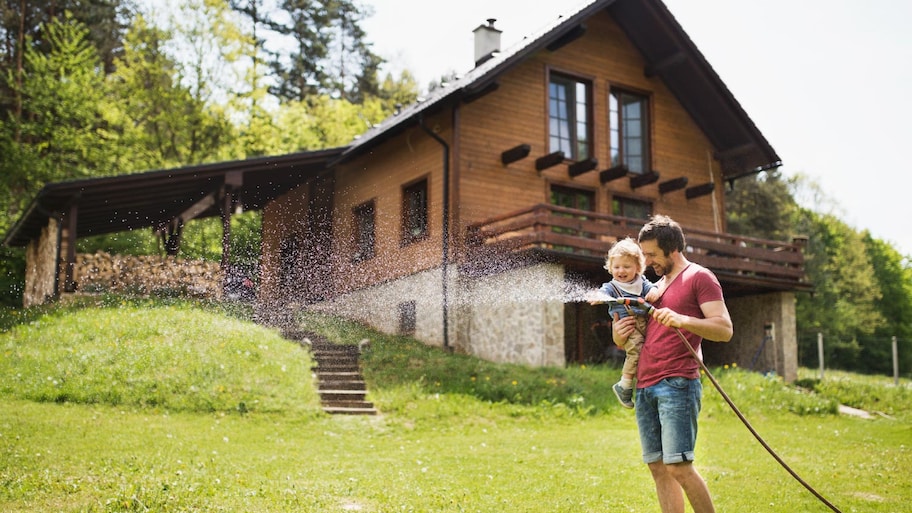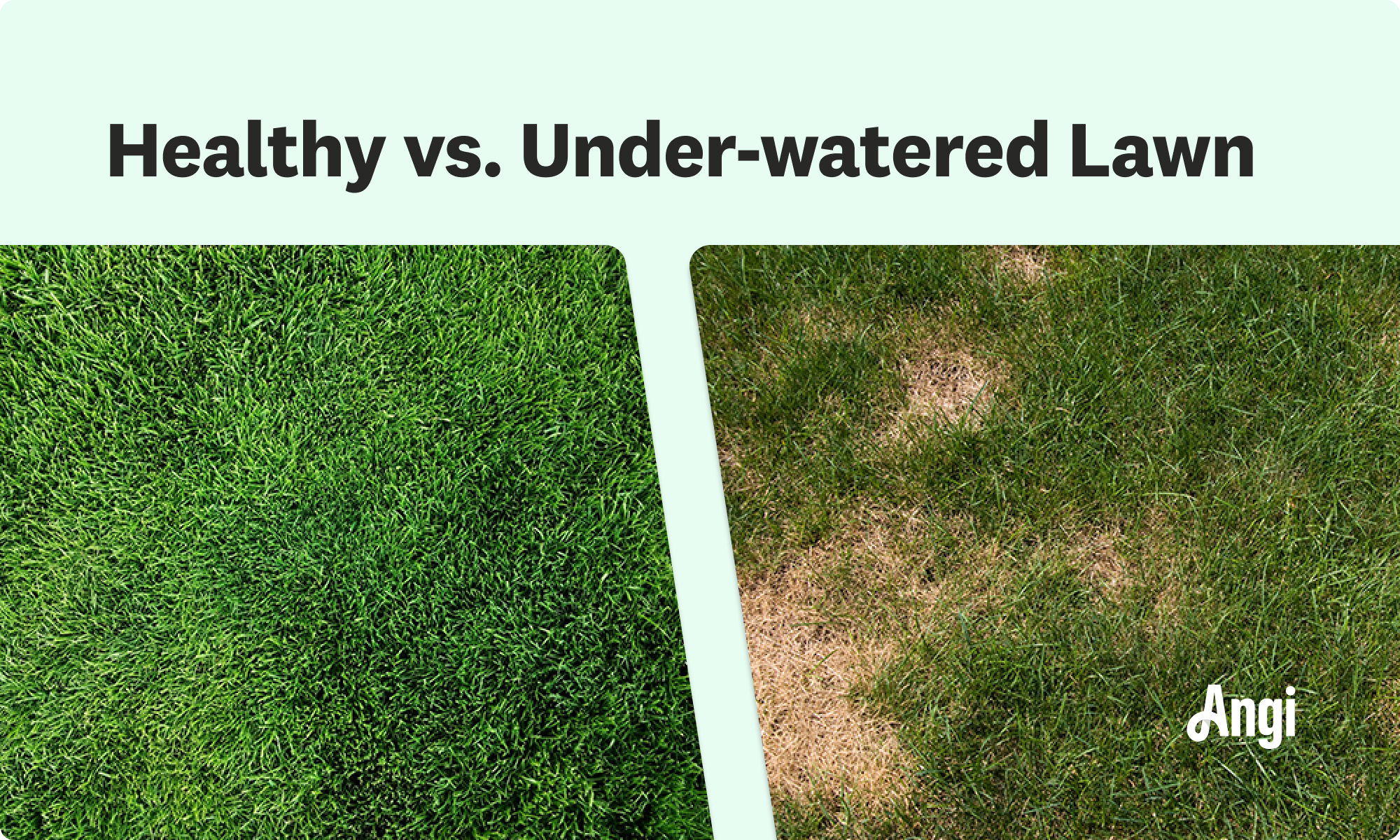When Is the Best Time to Water Your Grass? Good News for Early Risers
There’s nothing like a fresh spritz of water first thing in the morning


Highlights
Watering your lawn at night can cause fungal infections and other diseases.
The best time to water is first thing in the morning, before 10 a.m., but late afternoon and early evening can work, too.
Most established lawns need about an inch to an inch and a half of water per week.
Watering when it’s 95 degrees Fahrenheit or hotter won’t be effective.
Everyone knows a well-maintained lawn requires watering. But the best time to water grass and how much water to use can be harder to discern. While the answers vary a bit depending on what type of grass you have, where you live, and how much rain you’re getting, there are some basic rules of thumb to follow that can help keep your grass as green and happy as possible. For starters: When it comes to your watering schedule, you may want to wake up early.
Rise and Shine: Your Lawn Is a Morning Person
Although it may seem like water is water at any time of day, when it comes to watering your lawn, what the clock says matters. If you wait until late in the evening, the water will evaporate so slowly that you risk creating an environment where fungus and disease can fester. But if you water during the heat of the day, evaporation will occur so fast that your lawn won’t get the hydration it needs.
That’s why the best time to water your grass is at dawn before the sun is fully up and broiling because there’s still plenty of daylight on its way to help keep fungal growth at bay. Many experts recommend watering between 6 a.m. and 10 a.m.
Fortunately, if you’re not the type to set an alarm clock, you can also water in the late afternoon or early evening, at least a few hours before the sun goes down, with success. Depending on the season and when sunset occurs in your area, sometime between 4 p.m. and 6 p.m. should work.
What Temperature Is Too Hot to Water Grass?
The hotter it is outside, the more water your lawn needs, right?
Well, to some extent, yes—but there also is such a thing as it being too hot to water the grass at all. Again, because of the magic of evaporation, once the temperature hits 95 degrees Fahrenheit, you may as well not even water your lawn in the first place. Why? The water will dry up almost instantly and won’t have a chance to penetrate the soil, meaning you’ll just be wasting water (and money).
The best time to water your lawn in the hot weather is—you guessed it—in the early morning or early evening, as discussed above. However, hot and dry conditions can definitely impact how much watering your lawn needs on the whole. Let’s take a closer look.
4 Signs Your Lawn Needs Watering

While some gardeners stick to a pre-set watering schedule—perhaps three days per week in the spring and summer and two days per week in the fall—if you pay attention to your lawn, it’ll actually tell you when it needs to be watered.
While sticking to a pre-set schedule can help avoid the slight dehydration that causes these signals, overwatering can be just as damaging to your grass. So long as you don’t let it go too long, it’s okay—even important—to let your lawn dry out a little bit between waterings. Watering thoroughly, but infrequently, can actually help your grass root down more deeply and strongly.
Here are some signs that it’s time to bust out the water hose again:
Your lawn appears dull and grayish in color: If your grass doesn’t appear as shiny and vibrant as it once did, it may be in need of watering. (Keep in mind that sometimes, a brown color might actually indicate that your grass is dormant—not that your grass is dying.)
The blades of grass are curled: Like other types of plants, the leaves of the grass—also known as blades—will begin to curl when the plant is dehydrated.
When you walk across the lawn, your footprints stay: If your lawn is well hydrated, the footprints you leave behind when you walk across its surface will spring back within just a few seconds. If the prints remain longer—or worse, don’t disappear at all—it’s probably time to turn on your sprinklers.
The lawn feels, or sounds, dry: If you hear a “crunch” when you walk across the lawn, it’s time to get those thirsty blades some water.
How Much to Water Your Lawn and How to Tell When It’s Had Enough
Now you know how to tell when your lawn could use some water. Next up: How to tell how much water it needs.
Most established lawns need about an inch to an inch and a half of water per week, and sometimes more when it’s very hot or dry. That’s how much water it takes to ensure the top 6 to 8 inches of soil are moist—which is where the grass roots live. Many gardeners choose to spread that amount out over two or more waterings each week to avoid drenching their lawns once weekly and potentially overwatering. (A newly seeded lawn requires less water more frequently—enough to keep the top inch of soil moist on a consistent basis.)
So, how can you tell when you’ve achieved that goal? Fortunately, there are a few different ways:
Check the soil using a screwdriver once every 15 minutes while watering: Keep track of the time. Once the screwdriver easily penetrates 6 to 8 inches into the soil, the lawn has had enough—and you’ll know how much time it takes your sprinkler system to get there.
Multiply the square footage of your lawn by the magic number—0.62: Then, divide the figure you get by your sprinkler system’s flow rate (which you can find in your user’s manual). The resulting number is how many minutes you need to run your sprinkler system to get one inch of water per square foot into your lawn. Presto!
Grab some empty cans: Placing empty cans around your yard makes it much easier to see how much watering you’ve done in inches. Just be sure to put the cans in a variety of different spots since sprinkler coverage may vary.
Consider a flow timer: Again, you’ll use the magic number—0.62—to multiply with your lawn’s square footage to figure out the total number of gallons you need in order to put one inch of water into your yard. Set your flow timer to match that figure, keeping in mind that it likely measures water flow in hundreds of gallons.
Need More Help Quenching Your Lawn’s Thirst?

For many gardeners, watering the lawn doesn’t have to be a big hassle. Once you know how much your grass needs and when, it’s much easier to ensure you’re meeting those needs properly.
A sprinkler system can definitely make the task even simpler, though. With some of the newfangled systems on the market, with built-in flow timers and automatic schedules, the process can be as simple as setting it and forgetting it.
Installing a sprinkler system can be a big job, though—and an important one to ensure your lawn is evenly watered and as healthy as possible. So, hiring a local sprinkler installation professional is the best choice for your time and your yard’s health.
Keep in mind, too, that your grass needs more than just watering. Aerating your lawn, for instance, can help your grassroots get more of the ventilation, moisture, and nutrients they need to grow strong. You may want to consider dethatching and fertilizing, too. It’s all about keeping it green, baby!
Frequently Asked Questions
Avoid watering your lawn at night. Without the sun to help the natural process of evaporation, water could sit on your grass and create conditions for fungal growth and other diseases. First thing in the morning is an ideal time to water your lawn, but late afternoon or early evening hours can also work, so long as it’s not more than 95 degrees out.
Many experts say anytime before 10 a.m. is a good time to water grass, but this does depend a bit on the climate conditions where you live. For example, if you live in South Florida and it’s already 95 degrees by 7:30 a.m., it may simply be too hot to effectively water your lawn, regardless of what the time is.
Yes, it’s acceptable to water the lawn in very hot weather, but you should try to water between 6 a.m. and 10 a.m. for best results. However, watering when the temperature is above 95 degrees is ineffective. If you’re concerned about whether to water your lawn during extreme heat, consult a local lawn care professional who can recommend a watering schedule based on your grass type and climate.

